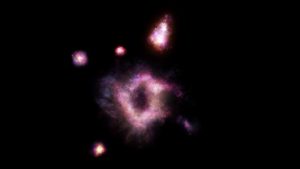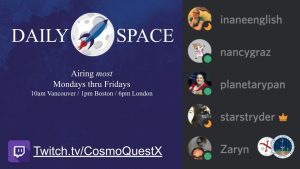Media
Transcript
This is a very special episode of the Daily Space coming to you LIVE from Balticon right here on the internet. During any other year, we’d be in Baltimore Maryland but this year the entire con has gone virtual.
Today isn’t just special because we’re coming to you from Balticon; it’s also special because today, Virgin Orbit is launching its first cubesat at any time between now and 4 hours from now.
And as always… we have the news. So, this episode is going to be jam-packed with more than normal for even us.
As part of today’s episode, we’ve been asked by the good humans at Balticon to let you all in behind the scenes of our little show. Joining me in just a few minutes are just some of our team members:
Beth Johnson on the Social Media,
Ally Pelphrey on Audio and Video Engineering
And not appearing today are Nancy Graziano, our Community Manager, and Annie Wilson, host of Rocket Wednesdays and keeper of the space toilet statistics.
We are also helped by a myriad of volunteers.
Before we bring them on however, let’s do what our audience on Twitch.tv/CosmoQuest is waiting for – Let’s get to the news!

CREDIT: James Josephides, Swinburne Astronomy Productions
Today, we have just one science story, and it has one terribly large hole poked through the center of it; a literal hole scientists are having fun explaining. This artist’s rendition shows you what appears to be a messy ring of star formation with nothing in the center. The actual tiny blob of light observed with Hubble and Keck lacked the pixels to make this appear pretty and only shows what is happening in a single filter. Named R5519, this object is located 11 billion light-years away, and we’re seeing how it appeared just a few billion years after the Big Bang. As keeps coming up in a case of science on repeat, no one expected there to be a lot of fully formed, major spiral galaxies already existing at that point in the universe’s history, but here we are, again, looking at something that can only be explained by rapid galaxy formation.
The global team studying this object, which was led by Tiantian Yuan, believes they’ve found the carnage of a galaxy collision, where one system punched a hole through the disk of another system. These kinds of collisions are exceedingly rare but have been seen before in the current universe, where galaxies are often found in groups and clusters, and there are more fully formed galaxies than we believed existed in the early universe. Despite all the news in the past week about fully formed galaxies being found by 2 billion years after the Big Bang, we’re still going to stick with – there were fewer then, and galaxies were still actively forming.
Despite the spread-out nature of these early galaxies, and their smaller numbers, R5519 makes it clear that when a galaxy really wants to punch something, it will find a way, and some galaxy definitely found a way to punch all the way through R5519. This event left a dark empty void in this Milky Way galaxy-sized system, and triggered massive amounts of star formation; the ring that the team sees is undergoing 50 times the rate of star formation of our own galaxy!
This work is published today in the journal Nature Astronomy. In this paper, they go on to argue that this discovery may imply that these kinds of collisions may have been more common in the early universe. As personal commentary, I’d like to say, I’m not sure we can say that yet. What this discovery tells us is there is a ring galaxy where they happened to be looking, and given all the remarkable things that we have reported on in the past few weeks, I think it’s time to reset our expectations of what was happening in the first few billion years of the universe because clearly, no one was expecting this or any of the other remarkable stories of massive galaxies that have been coming out in the past 3 weeks.

CREDIT: Virgin Orbit
From distant galaxies, we now turn to local launches. Today, Virgin Orbit is going to attempt to launch a cubesat on its LauncherOne rocket from the belly of a modified 747. This Richard Branson-owned company is a sister to Virgin Galactic, and like its sibling, this company looks to avoid the hold-ups in access to space that can happen at spaceports like Kennedy when multiple companies can’t readily have their rockets sitting all lined up at once, ready to launch. Instead of waiting for the range to clear, this aircraft just needs a runway and open skies. The way this works is the 747 takes off, climbs to a high altitude, and then drops a 2 stage rocket that can carry up to 500 kg of cargo to low earth orbit. Since they’re launching from an airplane, they are open to all kinds of orbits, ranging from 0-120deg, meaning their only real limitation is they need some of the Earth’s rotation to not be working against them as they try to get to orbital speeds.
There is no live stream of this launch, but we are monitoring Twitter and will let you know what happens when we know.

And finally, I’m not going to say I’m bringing on our guests. Instead, I’m going to say I’m tearing back the curtain to introduce you to just some of the amazing people responsible for making this daily news show happen.
Learn More
Astronomers see ‘cosmic ring of fire’, 11 billion years ago
- Science in Public news article
- “A Giant Galaxy in the Young Universe with a Massive Ring,” Tiantian Yuan et al., 2020 May 25, Nature Astronomy (Preprint)
Virgin Orbit’s first orbital test flight cut short after rocket released from carrier aircraft
Virtual Balticon 54: The Maryland Regional Science Fiction and Fantasy Convention
Credits
Written and Hosted by Pamela Gay
Audio and Video Editing by Ally Pelphrey
Content Editing by Beth Johnson
Intro and Outro music by Kevin MacLeod, https://incompetech.com/music/


 We record most shows live, on Twitch. Follow us today to get alerts when we go live.
We record most shows live, on Twitch. Follow us today to get alerts when we go live.